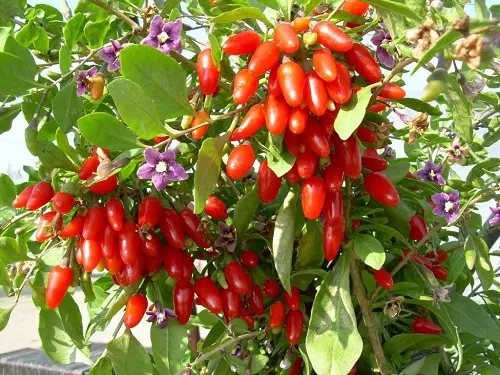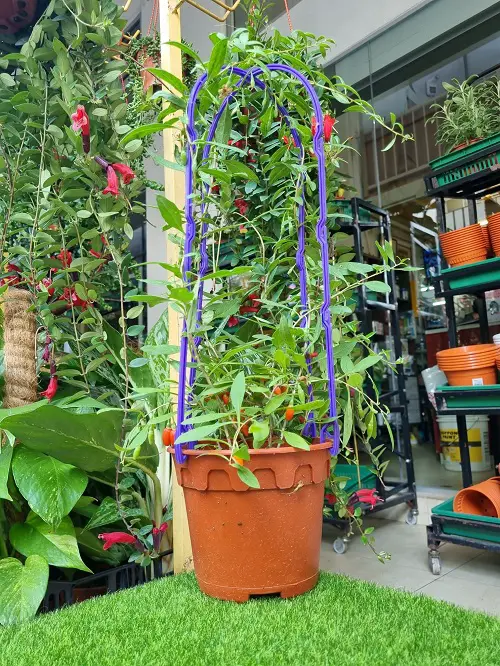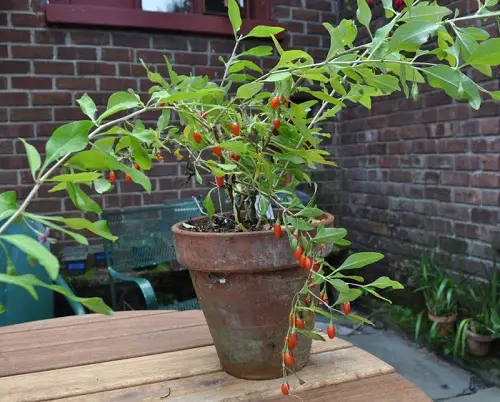Growing Goji Berries is easy and you can also cultivate them easily in pots. Here are all the details on How to Grow Goji Berries!

Also popular as wolfberry, Growing Goji Berries is the best way to enjoy their juicy taste fresh! If you have always wanted to harvest them at your home, then here are all the details on How to Grow Goji Berries in pots.
Botanical Name: Lycium barbarum
Here are the best berries to grow in pots
Goji Berry Information
Used in traditional Chinese medicine, goji berries are very valuable and nutritious. They are rich in carotenoids, beta carotene, vitamin C, B, and E, with more than 30 trace elements, antioxidants, and 19 amino acids.
The fruits appear as orange-red berries with a bright color in an elongated shape, with a slightly sour flavor. They can be eaten fresh, made into juice or wine, and as a snack. The bark of this plant can be used in teas and infusions.
There are two varieties of goji berry plants – Lycium Chinese, which bears small-sized berries, and Lycium Barbarum, having sweeter berries.
This highly branched, deciduous, and slightly thorny shrub grows up to 3-5 feet tall and wide in its natural form.
Other Names: Chinese wolfberry, Chinese boxthorn, Himalayan goji, Tibetan goji, mede berry, barbary matrimony vine, Duke of Argyll’s tea tree, Duke of Argyll’s tea plant, Murali, red medlar or matrimony vine.
How to Grow Goji Berries?

Goji berry plants can be propagated by seeds, cuttings, division, and layering.
- Buy seeds or take them from dried goji fruit.
- In spring, sow seeds in the moist substrate and keep them in a warm place, optimum germination temperature is around 20 C. The germination takes place between 7 to 15 days.
- Transplant seedlings immediately after two weeks. To avoid stress in a pot or on the ground while handing the roots gently.
To save time, it would be a good idea to get a well-grown plant from a garden center.
Learn all about growing raspberry in pots here
Growing Goji Berries in Pots
Growing goji berry in containers is possible. Make sure you take a pot that’s at least 2-12 inches deep and wide. Use a light potting mix and re-pot the plant once in 2-3 years depending on its growth and spread.
Requirements for Growing Goji Berries

Requirements for growing goji berries are somewhat similar to tomatoes.
Location
If you want the best-sized and juiciest berries, then make sure it gets a minimum of 4-6 hours of direct sunlight. The plant will grow in shade too, but the berries won’t be as good.
Soil
Wolfberry plants are not demanding when it comes to soil and grows in almost any soil type with good permeability. Soil pH should be neutral, around 6-6.5.
Compost and aged manure are a must for excellent growth. You can also check out our great DIY potting mixes here.
Watering
In the first year, keep the plant well-watered. Maintain the soil moisture in summer. In winter, reduce the watering, or even there is no need to water if the plant is grown on the ground. In the pot, water it three times a week in summer, and once in winter.
Goji Berry Plant Care

Pruning
Goji berry plant bears fruit on the present year’s wood grown in the fall or spring. Pruning is done to limit the height of the plant, improve light penetration and air circulation, and encourage the growth of lateral branches to increase fruit production.
Prune when the plant is not actively growing, usually in early spring, to remove lanky canes, along with the dead and damaged wood.
Pinching
As with many other plants, this technique is implied to stimulate the development of lateral branches. To perform the pinching, just press the stem between the thumb and forefinger around the apex in order to remove the top.
Pests and Diseases
If growing conditions are met, goji plants are not prone to any specific pests or diseases. Its leaves can be eaten by slugs and fruits are eaten by birds and caterpillars.
Harvesting Goji Berries

When growing goji berries, you must know that the plant takes at least 2-3 years to produce fruits and reaches its full capacity in 4 to 5 years. Harvesting is done when fruits are soft and red.
Pluck them without causing any damage to the plant. The fruits taste best when fresh but you can also store them refrigerator for 1-2 weeks.



Growing and fruiting are not a problem …. But getting a good crop is! Also , although I grow from bought fruit, the grown fruit is not at all sweet. What can I do? Thanks
Wondering if asparagus can be grown in pots?
Mine have been growing in a pot 2 seasons now because I don’t have the planting bed ready that I want to put it in. This year I actually had quite a few NICE stalks, enough for snacking while I am gardening. I think they will do better in the ground so I am hoping to get that bed ready for them this fall.